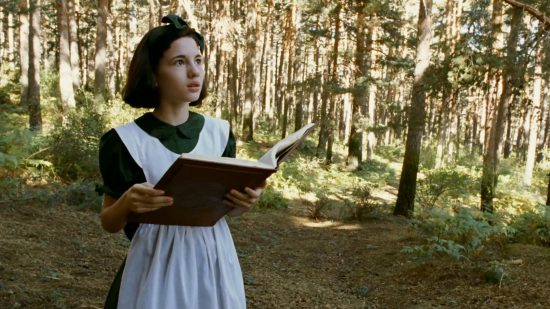Review: Pan’s Labyrinth – “Del Toro’s most beautiful and haunting film to date”
When we hear the name Guillermo del Toro, the first films that come to our minds are usually Pacific Rim (2013) Del Toro’s highest grossing film to date, and Crimson Peak (2015) his most recent film, two visual masterpieces that resonated in cinemas worldwide. However, these films pale in comparison to Del Toro’s most beautiful and haunting film to date; Pan’s Labyrinth (Spanish: El Laberinto del Fauno). Filmed in Spain and produced by a Mexican team, ten years later, the film remains one of the best examples of both Latin American cinema and the new wave of Latin filmic talent rising to prominence with figures such as Alejandro González Iñarritú (Birdman, The Revenant), Alfonso Cuarón (Children of Men, Gravity), Alfonso Gómez Rejón (Me and Earl and the Dying Girl) at the helm, among many others.
The film is set in 1944 and follows the story of 11 year-old Ofelia, an imaginative girl brought reluctantly by her mother into the home of her new stepfather Vidal – the Captain of a battalion assigned to hunt down rebels in Civil War era Spain. In this old house, she discovers a labyrinth, inhabited by a mysterious faun (Doug Jones) who believes she is the reincarnated soul of Princess Moanna, daughter of the king of the underworld. In order to prove that she is in fact the princess and to reclaim her throne, she must complete three tasks that the faun sets for her. At the same time, Captain Vidal must deal with the rebels that seem to be hiding in the mountains near his home.
From the opening scene, Del Toro sets the tone for film’s the visual style, a combination of a dark, sad, war ridden Spain with a surreal, fairy tale world created by Ofelia’s imagination. It comes as no surprise that the film won the Oscar in 2007 for best cinematography – every shot is so beautifully framed and composed to such detail, that it feels as if we’re watching a slideshow of paintings coming straight from the Mexican director’s darkest nightmares. This goes hand-in-hand with a fantastic score by Javier Navarrete (who was also nominated for an Oscar), that creates an ethereal, almost magical atmosphere that intertwines two worlds, making the audience question whether Ofelia’s imaginary, fairy tale world is her only means of escaping the tragedies of real life, or if the two worlds are in fact co-existing, without interacting. If the “real” world can be so cruel that a Captain can brutally murder two farmers under the (erroneous) suspicion that they are rebels, then what is so unrealistic about the haunting, human-eating creatures that Ofelia encounters? Needless to say, it serves as a criticism of the atrocities of war and the fine line that can be drawn between monsters and men, so it comes as no surprise that the innocent mind of Ofelia couldn’t tell the difference between fantasy and reality.
Guillermo Del Toro’s signature visual style and storytelling masterfully creates a film that feels like a grotesque, adult version of “Alice in Wonderland.” However in this case, the script (also written by Del Toro), doesn’t focus solely on the main character, but we also witness the dramatic events that unfold in the “real” or “adult” world from the point of view of both Captain Vidal and Mercedes, Captain Vidal’s housekeeper. Through the juxtaposition of two seemingly parallel stories, that are actually part of the same narrative loop, the brutal images of the war and the suffering Ofelia’s mother goes through leading up to giving birth, help elevate the tension we feel while Ofelia completes the faun’s dangerous tasks, a technique employed brilliantly by both Del Toro and his editing team. It’s hard not to mistake it with a children’s film at first glance, considering the fairies and the fauns, but in fact the film’s violence is very explicit and extremely complex with its symbols. Interestingly enough, when the film came out, so many children were taken to see it that cinemas in Spain and Mexico had to put up a sign warning parents of the mature content. Although, despite the mature subjects treated during the film, it’s presented in such a surreal way that even a mature audience can´t avoid getting caught up in this world of magic and fantasy, even if it seems treacherous and evil. It’s hard to imagine “fairy tale” and “war” being two genres inside a same movie, but that’s part of what makes Del Toro’s film so bold and powerful.
As far as the cast goes, none take center stage quite as much as Ivana Baquero (Ofelia), who at the time was 12 years old. Reportedly, Del Toro had originally written the script for a 9 year old girl but was so impressed by Baquero’s talent that he cast her instead and reworked the script to fit a girl her age. Despite it being her first big budget, high exposure film, her performance on screen would suggest the opposite. Although backed by the equally sensational acting from Sergi Lopez (Captain Vidal), Baquero’s breakthrough performance is so gripping that we can’t help but relate to her character’s misery and sympathize with her innocence. Not to be confused with ingenuity, however, as Del Toro’s brilliant character development makes a clear point of showing Ofelia’s perceptiveness – she’s the first one to notice that Mercedes, Captain Vidal’s housekeeper, is actually a rebel spy.
For newcomers to international cinema, this film is the epitome of what can be achieved on screen with good storytelling and a visionary mind. Like many Latin American directors, Del Toro uses film as a platform to criticize human nature and engage us in a timeless epic that stands out as a an artistic masterpiece amongst a barrage of cheesy comedies and over-the-top action films, whose only purpose is to appease a thrill-thirsty, short attention span audience.
You can follow me on Instagram.












Great review!. Agreed this is perhaps the most interesting Del Toro’s film. Hispanic-Latinamerica “Magic realism”… .
Thanks
Yep, one of my favourite’s and I really enjoyed Daniel’s review.
Very interesting and thorough review
I loved it!
Very good review of a good film!!